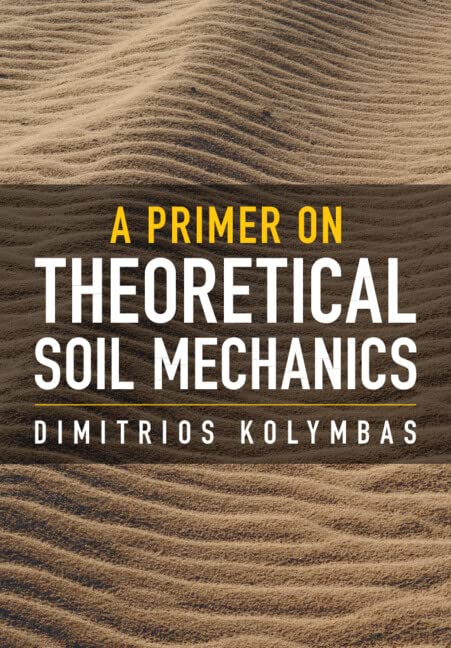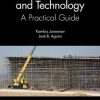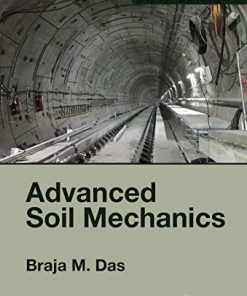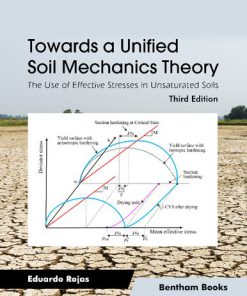A Primer on Theoretical Soil Mechanics 1st Edition by Dimitrios Kolymbas ISBN 9781009210331 1009210335
$50.00 Original price was: $50.00.$25.00Current price is: $25.00.
A Primer on Theoretical Soil Mechanics 1st Edition by Dimitrios Kolymbas – Ebook PDF Instant Download/Delivery: 9781009210331 ,1009210335
Full download A Primer on Theoretical Soil Mechanics 1st Edition after payment

Product details:
ISBN 10: 1009210335
ISBN 13: 9781009210331
Author: Dimitrios Kolymbas
A Primer on Theoretical Soil Mechanics 1st Edition Table of contents:
1 Granular Materials as Soft Solids
1.1 Soil and Geotechnical Engineering
1.2 Granulates in Chemical Engineering
1.3 Can We Consider Granular Media as Continua?
1.4 Differences between Granulates and Other Solids
2 Mechanical Behaviour of Soil: Experimental Results
2.1 The Meaning of Mechanical Behaviour
2.2 Element Tests
2.3 Typical Laboratory Tests
2.4 Oedometric Test
2.5 Drained Triaxial Test
2.6 Undrained Triaxial Tests
2.7 Cyclic Tests
2.8 True Triaxial Apparatus
2.9 Simple Shear
2.10 Strain- versus Stress-Control
2.11 Role of Time
2.12 Accuracy of Test Results
2.13 Looking into the Samples
3 Mechanical Behaviour of Soil: Intuitively
3.1 Equations versus Intuition
3.2 Proportional Paths for Granular Materials
3.3 Relation between Strain Paths and Stress Paths
3.4 Proportional Straining Starting at T ≠ 0
3.5 Triaxial Tests
4 Vectors and Tensors
4.1 Purpose of This Chapter
4.2 Vectors
4.3 Tensors
5 Fields
5.1 Fields in Continuum Mechanics
5.2 Coordinates
5.3 Vector Fields
5.4 Continuous Fields and Discontinuities
6 Deformation
6.1 Deformation and Grain Rearrangement
6.2 How to Describe Deformation?
6.3 Euler and Lagrange Approaches
6.4 Deformation Gradient
6.5 Rotation
6.6 Displacement Gradient
6.7 Time and Spatial Derivatives
6.8 Example: Simple Shear
6.9 Equations of Compatibility
7 Stress
7.1 What Is the Stress Tensor?
7.2 Mohr Circle
7.3 Principal Stress Space
7.4 Stress Tensor in Cylindrical Coordinates
7.5 Invariants and Eigenvalues
7.6 Example: Stress in a Shear Box
8 Conservation Laws (Balance Equations)
8.1 Integrals of Motion
8.2 Conservation Laws as Field Equations
8.3 Weak Solution of the Equilibrium Equation
8.4 Jump Relations
8.5 Integral Representations of Conservation Equations
8.6 Stress and Intergranular Forces
8.7 Stress Fields
9 Internal Friction and Shear Strength
9.1 Meaning of Strength
9.2 Dry Friction in Continuum Mechanics
9.3 Friction Angle
9.4 Cohesion
9.5 Rock as Frictional Material
10 Collapse
10.1 Importance of Collapse in Soil Mechanics
10.2 The Phenomenon of Collapse
10.3 Plastified Zones
10.4 Collapse Mechanisms
10.5 Safety
10.6 Imminent Collapse
11 Constitutive Equations
11.1 Constitutive Equation versus Constitutive Law
11.2 Why Do We Need Constitutive Equations?
11.3 Are Constitutive Equations Dispensable in View of Artificial Intelligence?
11.4 Material Constants
11.5 Calibration
11.6 Response Envelopes
11.7 Proportional Strain Paths
11.8 Large Deformations
11.9 Role of Thermodynamics
11.10 Comparison of Constitutive Equations
12 Elasticity
12.1 Definition of Elasticity
12.2 Linear Elasticity
12.3 Modifications of Elasticity
12.4 Elasticity in Soil Mechanics
13 Elastic Waves
13.1 Purpose of This Chapter
13.2 What Are Waves?
13.3 Kinematic Waves
13.4 Elastic Waves in One-dimensional Continua
13.5 Waves in Bodies of Finite Dimensions
13.6 Body Waves
13.7 Rayleigh Waves
13.8 Impairment Due to Waves
14 Plasticity Theory
14.1 Relevance of Plasticity Theory
14.2 One-dimensional Origin of Plasticity
14.3 Yield Function, Loading–Unloading
14.4 Normality Rule
14.5 Collapse or Limit Load Theorems
14.6 Elastoplastic Relations for Soil
14.7 Criticism of Plasticity Theory in Soil Mechanics
15 Hypoplasticity
15.1 Hypoplasticity as an Alternative to Elastoplasticity
15.2 Non-linear Rate Equations
15.3 Notation
15.4 Incremental Non-linearity
15.5 Mathematical Description of Irreversibility
15.6 Emergence of Hypoplasticity
15.7 Links to Elastoplasticity
15.8 Improving Memory by Means of Intergranular Strain
16 Barodesy
16.1 Introduction
16.2 Notation
16.3 Derivation of the Constitutive Equation
16.4 The Equations of Barodesy
16.5 Critical States Revisited
16.6 The R-function
16.7 Calibration
16.8 Simulation of Element Tests
16.9 Barodesy for Sand
16.10 Barodesy for Clay
16.11 Reflecting upon Barodesy
16.12 Numerical Simulation of Element Tests
17 Uniqueness
17.1 Meaning of Uniqueness and Related Notions
17.2 Uniqueness in Element Tests
17.3 Shear Bands and Faults
18 Symmetry
18.1 General Remarks
18.2 Principle of Material Frame Indifference
18.3 Isotropic Materials
18.4 Scaling
18.5 Mechanical Similarity
19 Interaction with Water
19.1 Water in Soil
19.2 Multiphase Materials
19.3 Effective Stress in Water-saturated Soil
19.4 Darcy’s Law
19.5 Balance Equations
19.6 Consolidation
19.7 Groundwater Flow
19.8 Unsaturated Soil: An Exkurs to Physical Chemistry
20 Computing in Soil Mechanics
20.1 Pitfalls of Computing
20.2 Problems with Geotechnical Engineering Computations
20.3 Limits of Continuum Mechanics
20.4 Quality of Numerical Results
20.5 Coping with Uncertain Predictions
21 Outlook
21.1 Open Questions
References
Index
People also search for A Primer on Theoretical Soil Mechanics 1st Edition:
a primer on the differential calculus of 3d orientations
a primer on theoretical soil mechanics
a primer on mapping class groups
a primer for the monte carlo method
a primer of infinitesimal analysis
Tags:
Dimitrios Kolymbas,Primer,Theoretical Soil Mechanics
You may also like…
Mathematics - Computational Mathematics
Earth Sciences - The Environment
Physics - Quantum Mechanics
Quantum Continuous Variables: A Primer of Theoretical Methods, 2nd 2nd Edition Alessio Serafini
Science (General) - International Conferences and Symposiums
Physics - Quantum Mechanics
Engineering - Chemical Engineering
Advanced SOIL mechanics 5th Edition by Das Braja M 9781351215169 1351215167
Engineering - Civil & Structural Engineering











